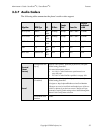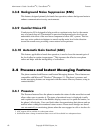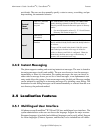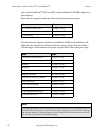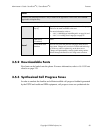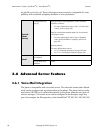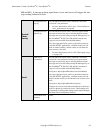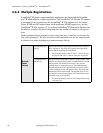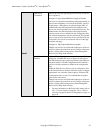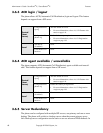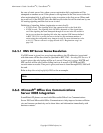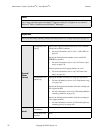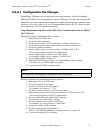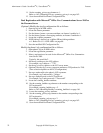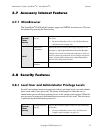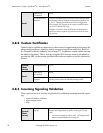
Administrator’s Guide - SoundPoint
®
IP / SoundStation
®
IP Features
Copyright © 2006 Polycom, Inc. 67
Local
Web Server
(if enabled)
Specify the local SIP signaling port and an array of SIP serv-
ers to register to.
Navigate to: http://<phoneIPAddress>/appConf.htm#se
For up to six registrations (depending on the phone model, in
this case the maximum is six even for the IP 601), specify a
display name, a SIP address, an optional display label, an
authentication user ID and password, the number of line
keys to use, and an optional array of registration servers. The
authentication user ID and password are optional and for
security reasons can be omitted from the configuration files.
The local flash parameters will be used instead. The optional
array of servers will override the servers specified in sip.cfg
in non-Null. This will also override the servers on the app-
Conf.htm web page.
Navigate to: http://<phoneIPAddress>/reg.htm
Changes are saved to local flash and backed up to <Ethernet
address>-phone.cfg on the boot server. Changes will perma-
nently override global settings unless deleted through the
Reset Local Config menu selection.
Local Phone User
Interface
Use the SIP Configuration menu to specify the local SIP sig-
naling port, a default SIP server to register to and registra-
tion information for up to twelve registrations (depending on
the phone model). The SIP Configuration menu contains a
sub-set of all the parameters available in the configuration
files.
Either the Web Server or the boot server configuration files
or the local phone user interface should be used to configure
registrations, not a mixture of these options. When the SIP
Configuration menu is used, it is assumed that all registra-
tions use the same server.
Changes are saved to local flash and backed up to <Ethernet
address>-phone.cfg on the boot server. Changes will perma-
nently override global settings unless deleted through the
Reset Local Config menu selection.
• For more information on the fields in this menu, refer to
4.6.1.1.1 Local <local/> on page 85, 4.6.1.1.2 Server
<server/> on page 85 and 4.6.2.1 Registration <reg/> on
page 149.



